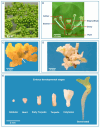Development and Applications of Somatic Embryogenesis in Grapevine (Vitis spp.)
- PMID: 39599340
- PMCID: PMC11597845
- DOI: 10.3390/plants13223131
Development and Applications of Somatic Embryogenesis in Grapevine (Vitis spp.)
Abstract
Somatic embryogenesis (SE) provides alternative methodologies for the propagation of grapevine (Vitis spp.) cultivars, conservation of their germplasm resources, and crop improvement. In this review, the current state of knowledge regarding grapevine SE as applied to these technologies is presented, with a focus on the benefits, challenges, and limitations of this method. The paper provides a comprehensive overview of the different steps involved in the grapevine SE process, including callus induction, maintenance of embryogenic cultures, and the production of plantlets. Additionally, the review explores the development of high-health plant material through SE; the molecular and biochemical mechanisms underlying SE, including the regulation of gene expression, hormone signaling pathways, and metabolic pathways; as well as its use in crop improvement programs. The review concludes by highlighting the future directions for grapevine SE research, including the development of new and improved protocols, the integration of SE with other plant tissue culture techniques, and the application of SE for the production of elite grapevine cultivars, for the conservation of endangered grapevine species as well as for cultivars with unique traits that are valuable for breeding programs.
Keywords: chimera; conservation; germplasm; in vitro culture; mutagenesis; propagation; somaclonal variation; tissue culture; transformation.
Conflict of interest statement
The authors declare no conflicts of interest.
Figures




Similar articles
-
Studies on Improving the Efficiency of Somatic Embryogenesis in Grapevine (Vitis vinifera L.) and Optimising Ethyl Methanesulfonate Treatment for Mutation Induction.Plants (Basel). 2023 Dec 11;12(24):4126. doi: 10.3390/plants12244126. Plants (Basel). 2023. PMID: 38140453 Free PMC article.
-
Somatic Embryogenesis and Genetic Modification of Vitis.Methods Mol Biol. 2016;1359:263-77. doi: 10.1007/978-1-4939-3061-6_11. Methods Mol Biol. 2016. PMID: 26619866
-
Grapevine Shoot Tip Cryopreservation and Cryotherapy: Secure Storage of Disease-Free Plants.Plants (Basel). 2021 Oct 15;10(10):2190. doi: 10.3390/plants10102190. Plants (Basel). 2021. PMID: 34685999 Free PMC article. Review.
-
Elevated transcription of transposable elements is accompanied by het-siRNA-driven de novo DNA methylation in grapevine embryogenic callus.BMC Genomics. 2021 Sep 20;22(1):676. doi: 10.1186/s12864-021-07973-9. BMC Genomics. 2021. PMID: 34544372 Free PMC article.
-
Transient expression assays in grapevine: a step towards genetic improvement.Plant Biotechnol J. 2014 Dec;12(9):1231-45. doi: 10.1111/pbi.12294. Plant Biotechnol J. 2014. PMID: 25431200 Review.
Cited by
-
Integrated Transcriptomic and Metabolic Analyses Highlight Key Pathways Involved in the Somatic Embryogenesis of Picea mongolica.Plants (Basel). 2025 Jul 11;14(14):2141. doi: 10.3390/plants14142141. Plants (Basel). 2025. PMID: 40733378 Free PMC article.
-
Harnessing clonal diversity in grapevine: from genomic insights to modern breeding applications.Theor Appl Genet. 2025 Aug 4;138(8):196. doi: 10.1007/s00122-025-04986-w. Theor Appl Genet. 2025. PMID: 40759826 Free PMC article. Review.
References
-
- Haberlandt G. Plant Tissue Culture: 100 Years Since Gottlieb Haberlandt. Springer; Berlin/Heidelberg, Germany: 2003. Culturversuche mit isolierten Pflanzenzellen; pp. 1–24.
Publication types
LinkOut - more resources
Full Text Sources
Miscellaneous

